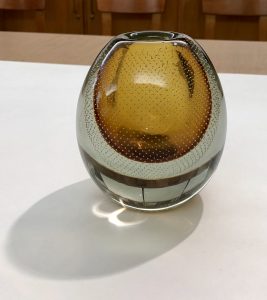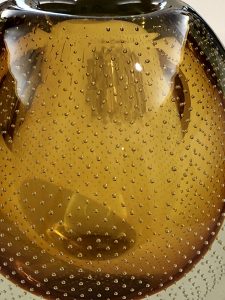
Pin-mold Vase, Gunnel Nyman, 1948.
This object immediately caught my eye because of its juxtapositions. The vase appears to be heavy and study yet is filled with tiny bubbles in the glass. Each bubble is precisely the same size and follows the same shape as the yolk colored object on the inside. To further complicate things, the object is not a solid oval. At the top of the object, it dips in to create a vase; however, the hole is too small to hold anything. Because of this, this object was created for aesthetic purposes rather than for function. It could perhaps be a paperweight because of its heft but it primarily appears to be a decorative object.

I have difficulty envisioning how the object was created because I have little experience with glass-work; this is because glass is not something that you can manipulate directly with your hands. Based upon how we interacted with glass in the laboratory glass studio, I think that the yellow sphere of this object was made by mouth blowing through yellow glass tube after it was heated to create a bulb-like shape. The tube is heated at one end, closed, and then blown into from the other end. From what I have seen at glass blowing studios, that is the normal process to create spherical objects. This process most likely used a furnace fire rather than a flame. It also was probably created with a tube larger than the one that we were able to use in class because the yellow object appears to be thick. When I was looking at the vase, the yellow interior appeared to be at least half an inch thick, requiring an even thicker tube to be manipulated.
Surrounding the yellow interior is a single layer of bubbles encased in glass. The description card of this vase lists “controlled air bubbles” as one of the materials of the object. This was the element that was the most fascinating to me but also the one that I had absolutely no idea how to approach. My initial idea was that each bubble was manually blown in but that could not account for how smooth the glass looked on the inside and outside. I was not able to understand how this could have been made using that method without causing flaws in the glass. Thus, I turned to the internet to get a better sense of how these bubbles could have been made. I was unaware of the vast variety of ways that bubbles in glass can be created, causing an even tougher challenge in understanding this object.

Air bubbles are often seen as an unsightly problem when fusing glass together but within the past century, artists have turned to the bubbles for aesthetics. When working with glass, the creator has to be aware of air bubbles as this is a major factor in how glass is created (this was directly seen when we played around with glass in the laboratory). The precise nature of the bubbles makes me believe that this was intentional and not an accident when fusing glass. Intentional methods of creating bubbles also includes adding chemicals to create reactions (like borax or baking soda) or by using mechanical methods (such as physically blowing bubbles or puncturing the glass before sealing it). When observing this object, I am inclined to believe that the bubbles were created as a result of a physical manipulation. When I was researching online, one way to create bubbles to to roll the molten glass around on a pointed metal surface, and then sealing it with another layer of glass. This seems like the most likely method to create such a precise, grid-like, single layer of bubbles. I think that a chemical reaction would create inconsistencies that I did not see in the glass.
The next step in creating this object appears to be surrounding everything, the yellow object and the bubbles, in a thick, clear layer of glass. The clear glass is thinner at the top when it meets the yellow interior and becomes thicker towards the bottom, creating an egg-like shape. The encasement is incredibly smooth and does not reveal any seams, showing off the skill of the artist. When looking at the object, everything appears to be encased in the clear glass. This could be made by, again, blowing the clear glass into the desired shape and then inserting the yellow interior into it when both are at high temperatures. Thus, the layers become sealed, creating this solid, egg-like vase. Afterwards, the artist most likely had to anneal the vase, or let it systematically cool down from its high temperatures, so that there would be no flaws in the finished object.